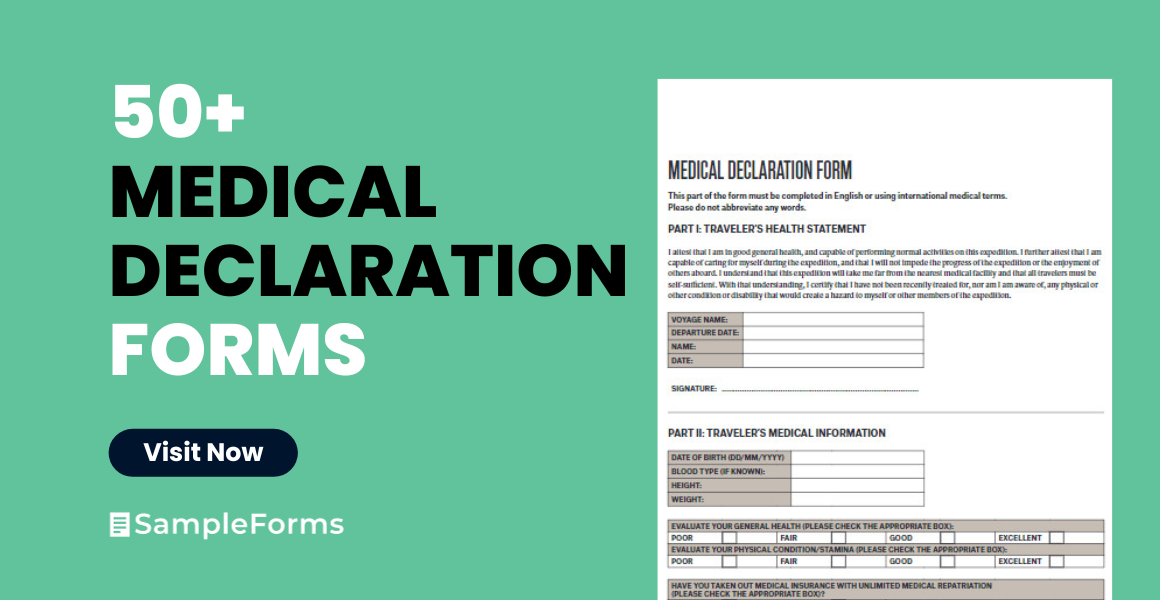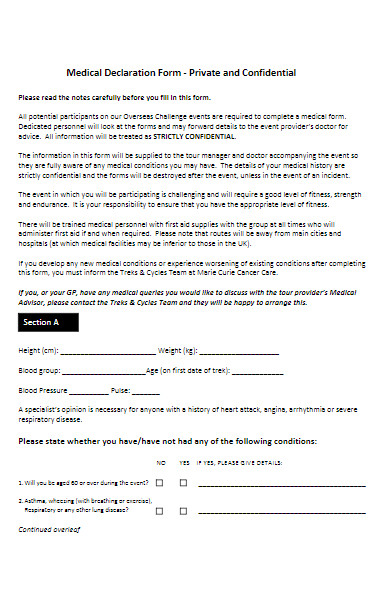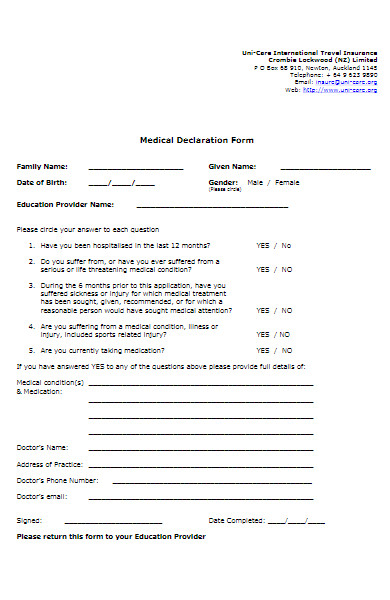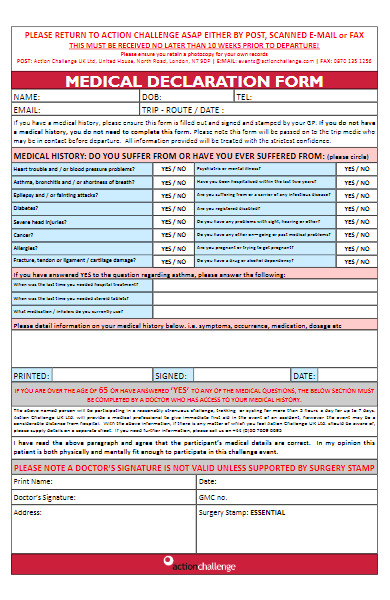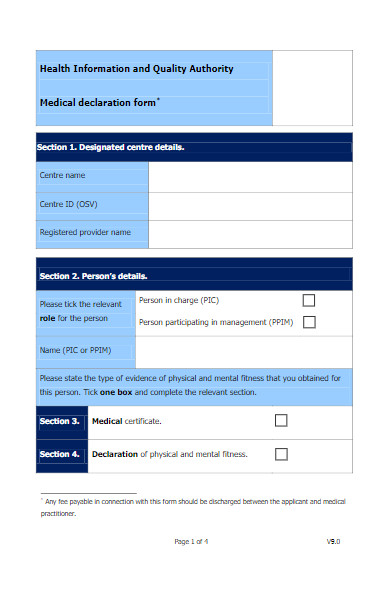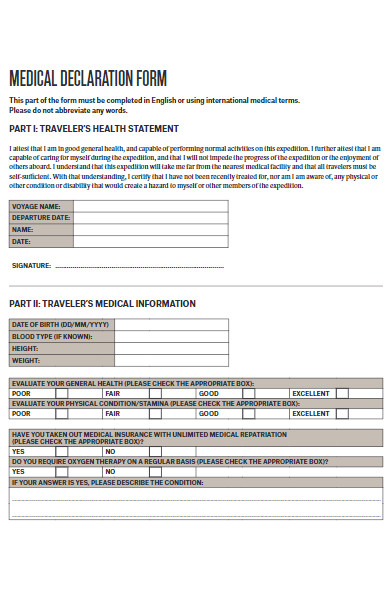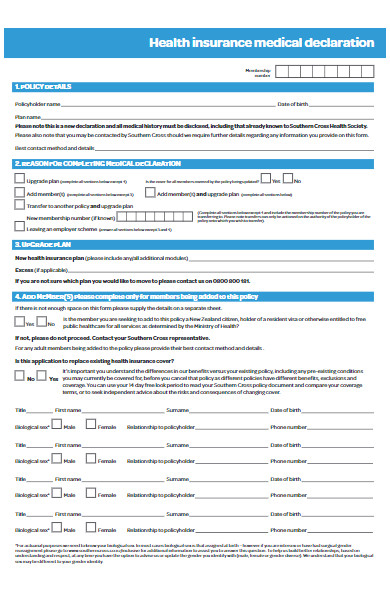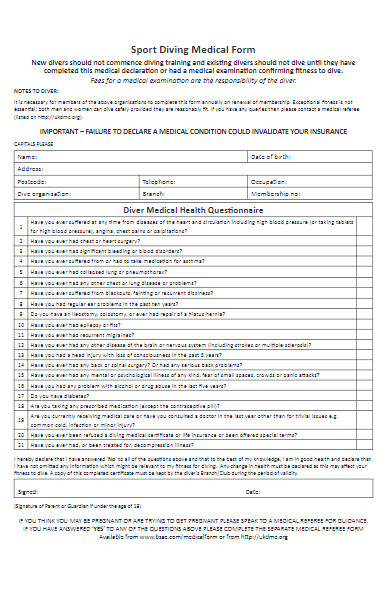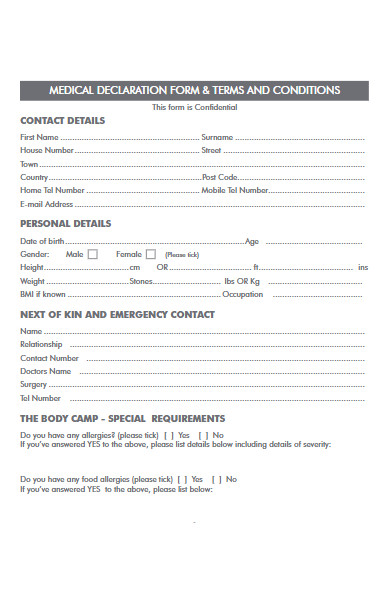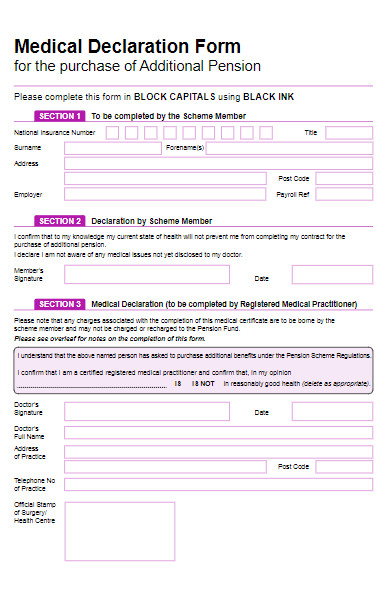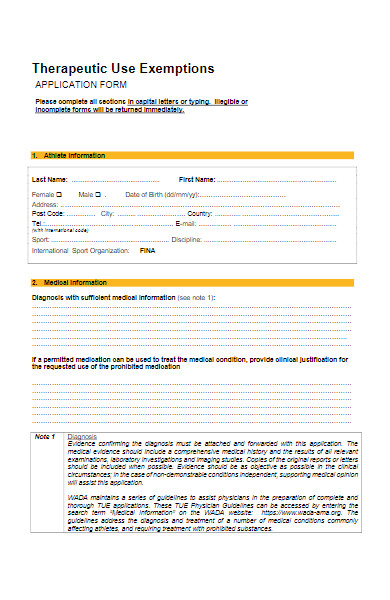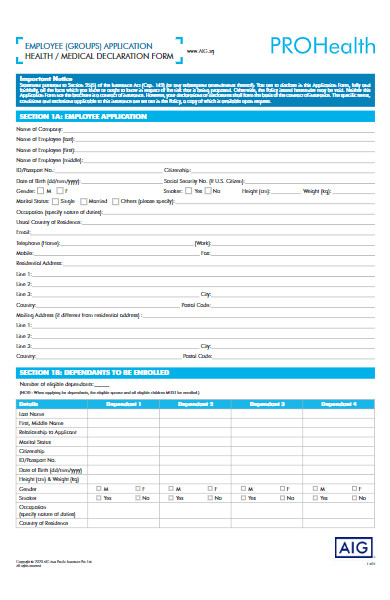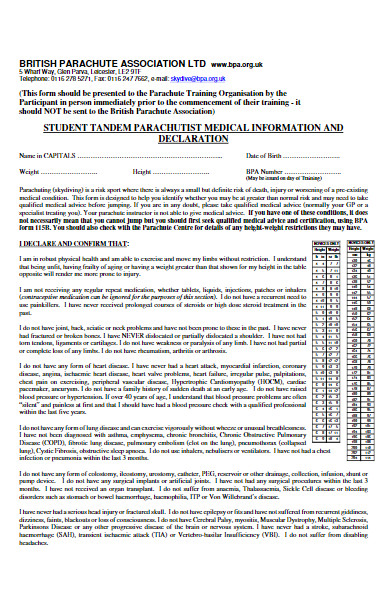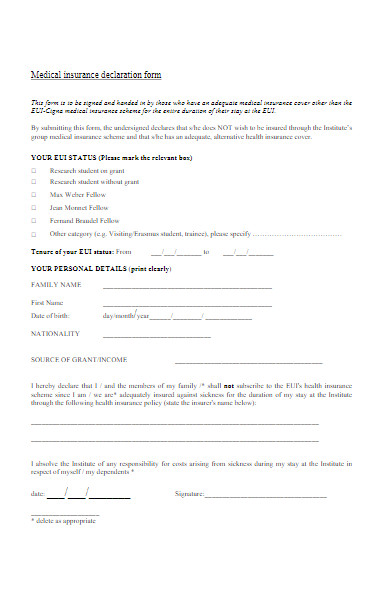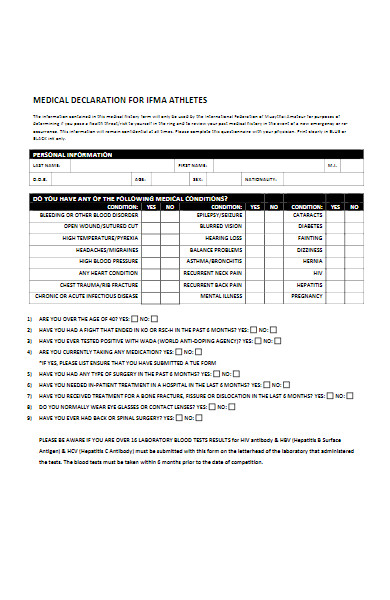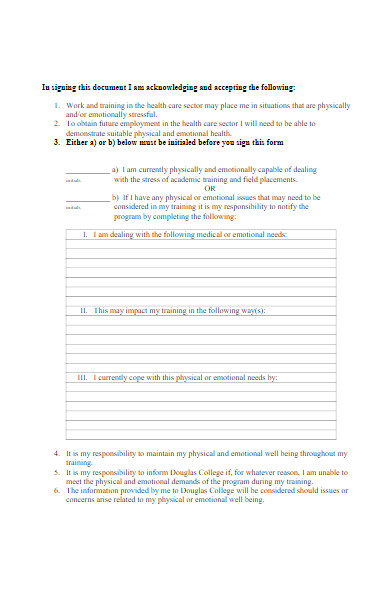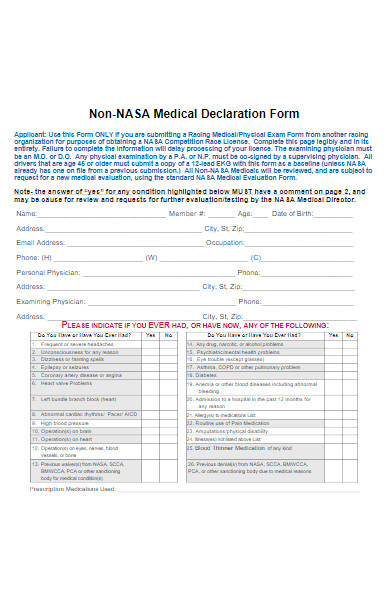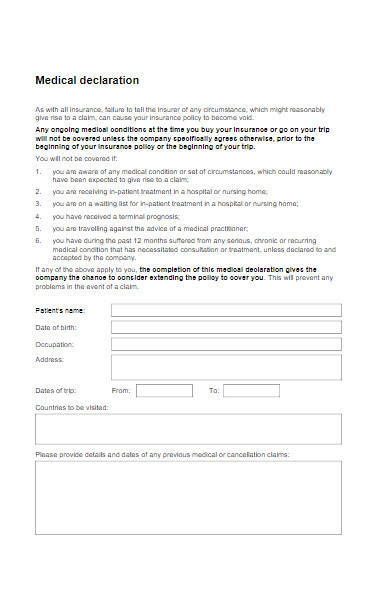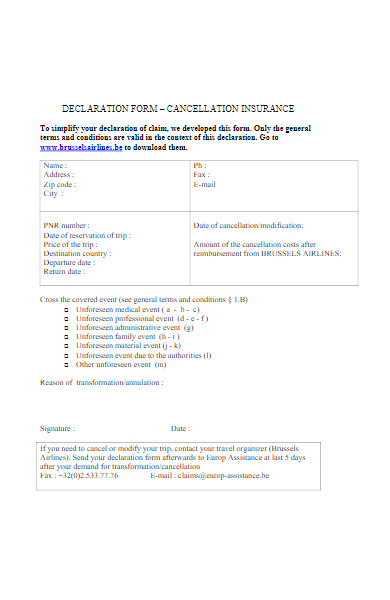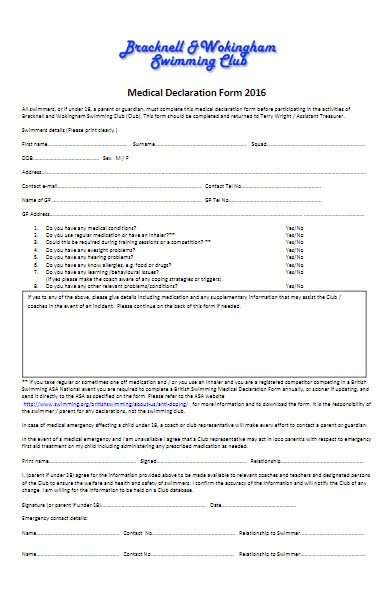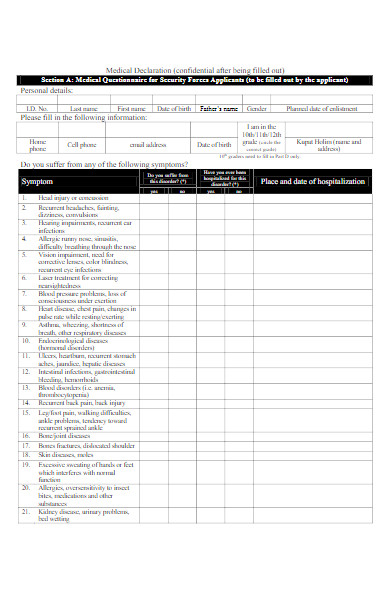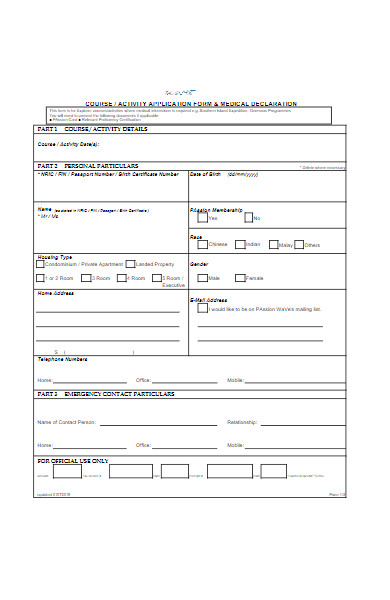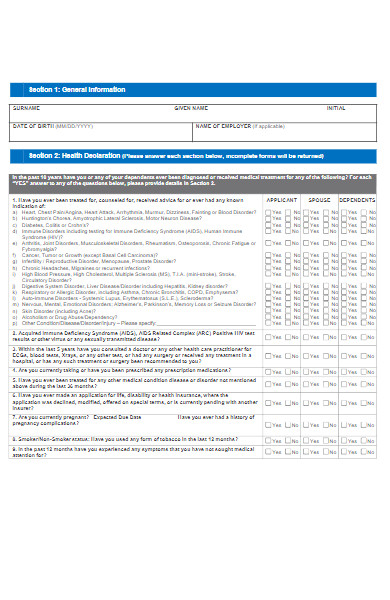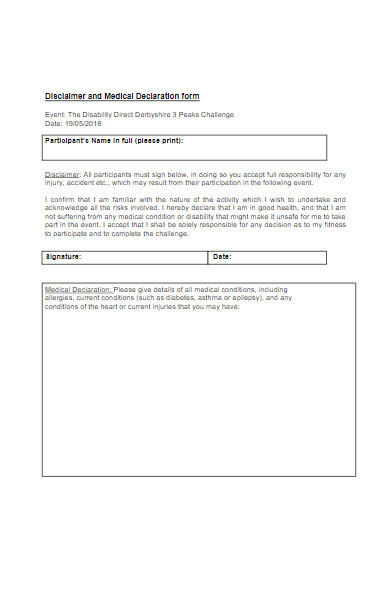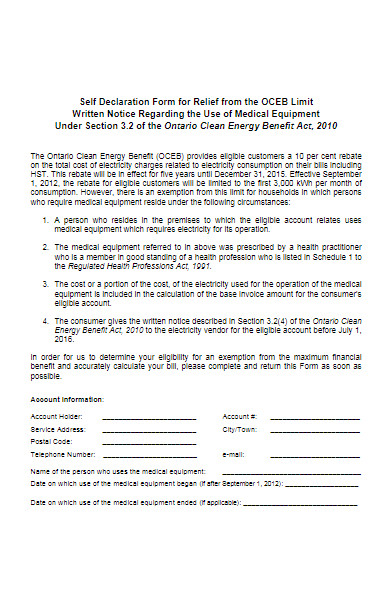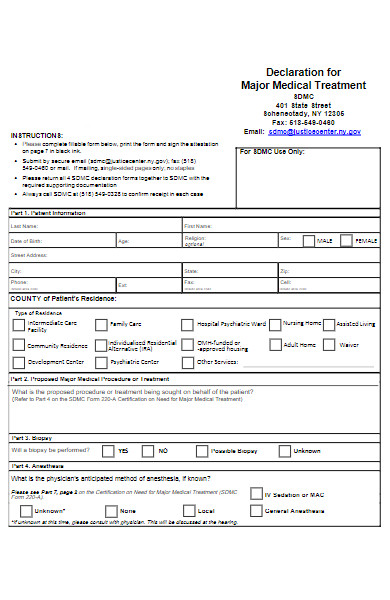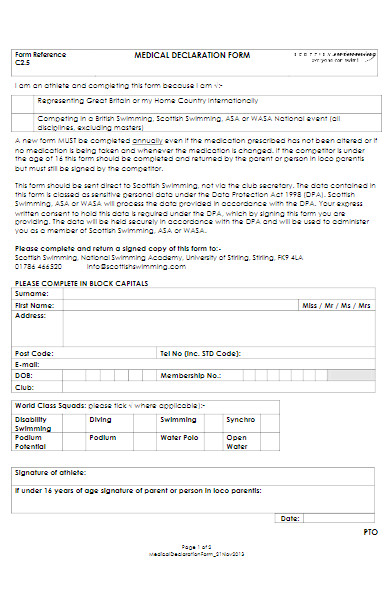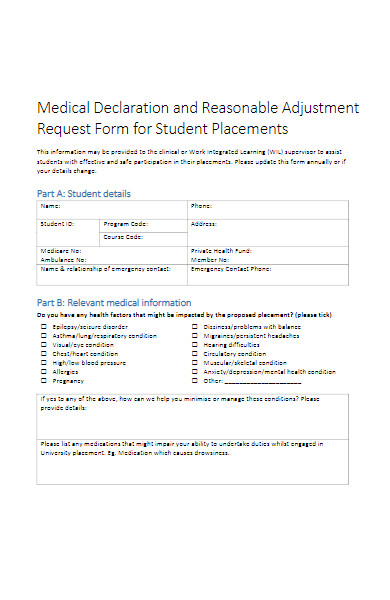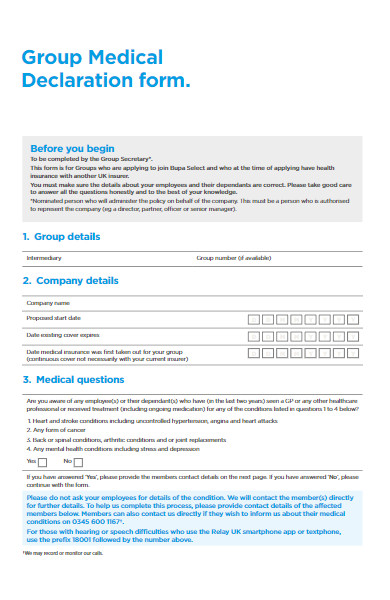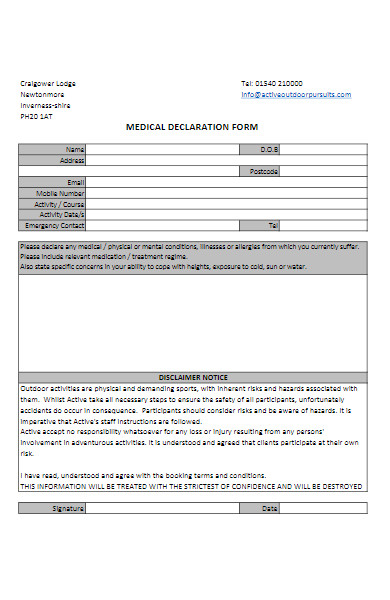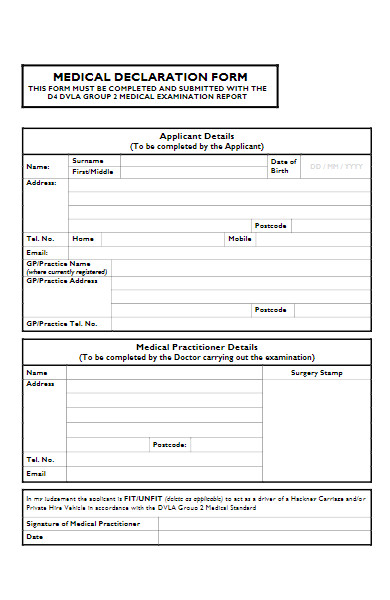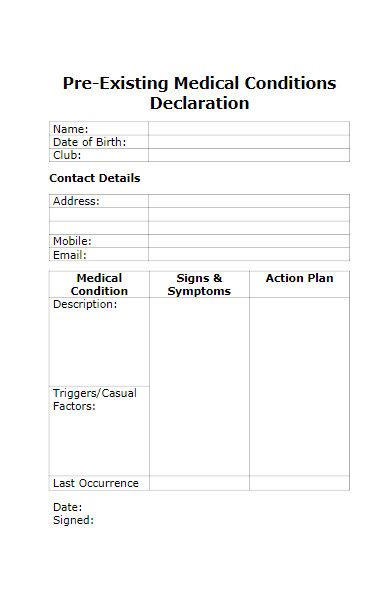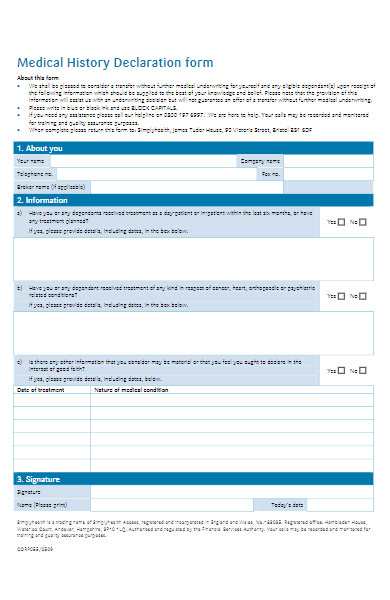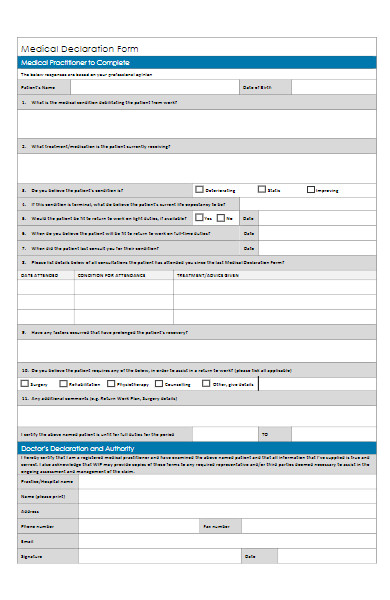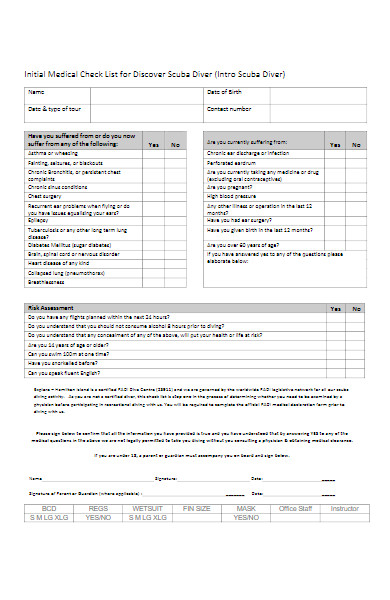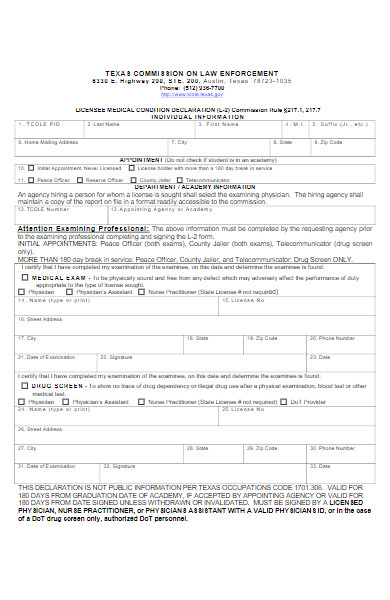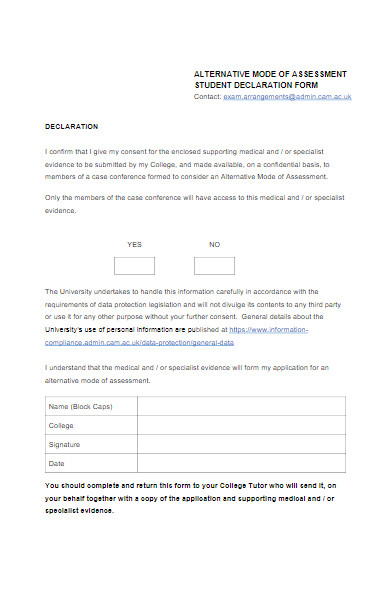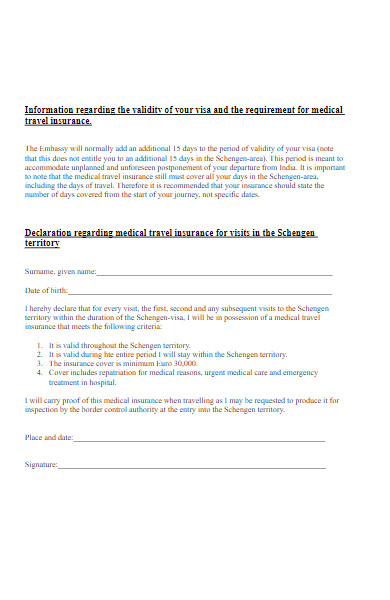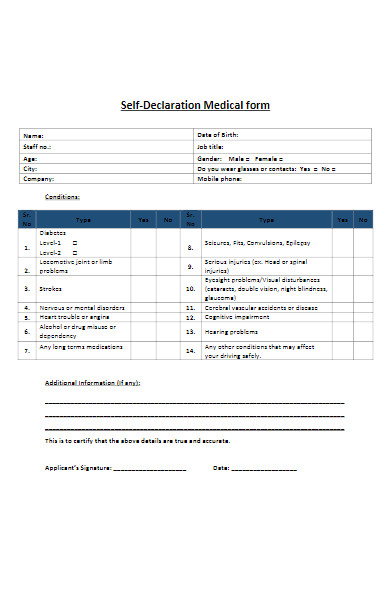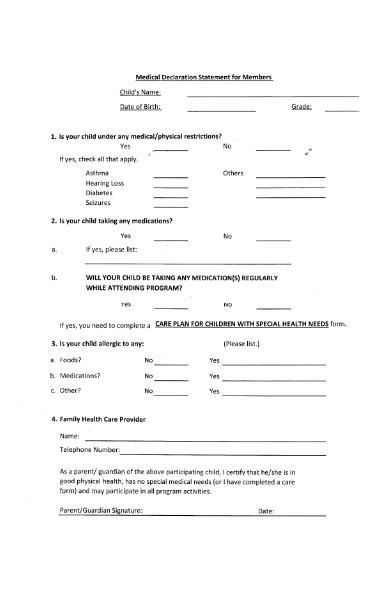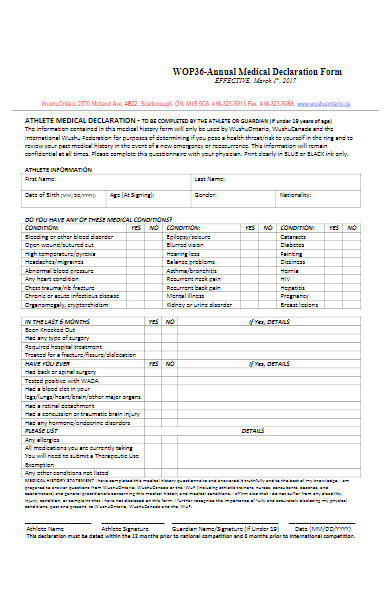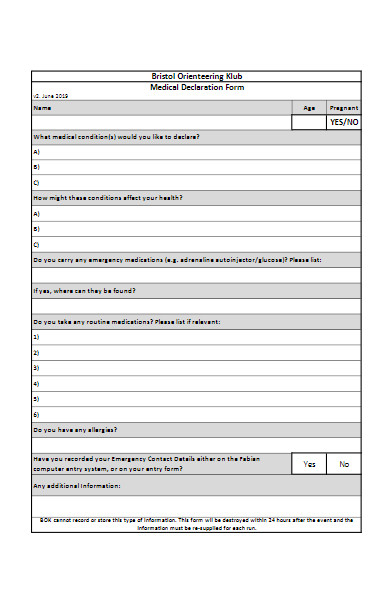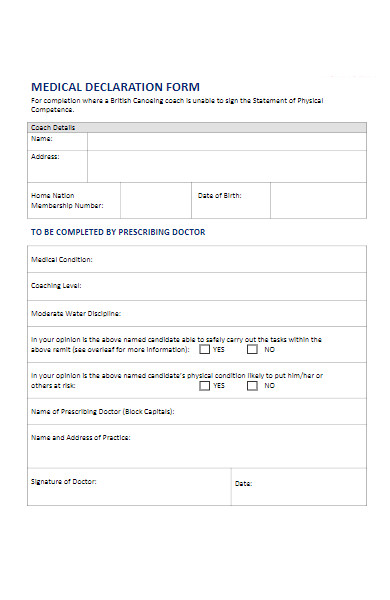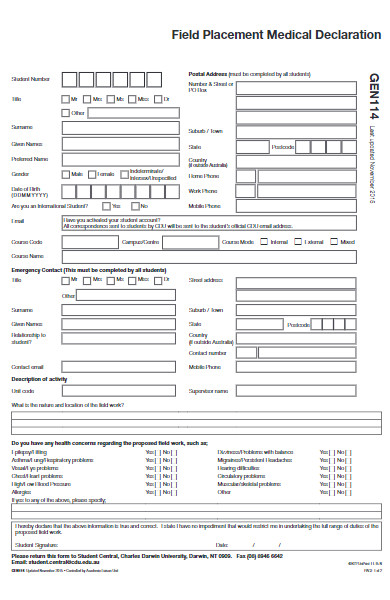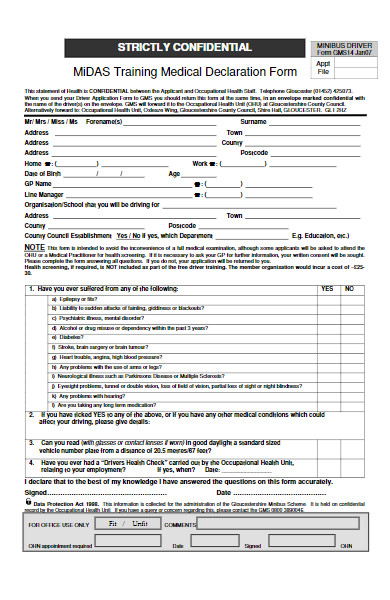Welcome to the comprehensive guide on Medical Declaration Forms! In the realm of healthcare, these forms play a vital role in ensuring your voice is heard and your medical choices are respected. From outlining your treatment preferences to designating decision-makers in critical moments, understanding the meaning, types, and practical examples of Medical Declaration Forms is essential. We’ll also delve into the step-by-step process of creating one and offer valuable tips to empower you on your healthcare journey. Let’s dive in!
What is a Medical Declaration Form? – Definition
A Medical Declaration Form, in essence, is a legal document that allows individuals to express their healthcare preferences, particularly regarding medical treatments, interventions, and decision-makers in case they become unable to communicate or make decisions themselves. This form serves as a means for individuals to assert their autonomy in medical matters, ensuring that their wishes are known and respected during times of incapacity or critical healthcare situations.
What is the Meaning of the Medical Declaration Form?
The meaning of a Medical Declaration Form lies in its role as a legal instrument for individuals to convey their healthcare preferences clearly. This document outlines a person’s choices regarding medical treatments, procedures, and the individuals authorized to make medical decisions on their behalf in situations where they are unable to do so themselves. It serves as a safeguard, ensuring that one’s healthcare wishes are understood and followed, thereby providing peace of mind and preserving personal autonomy in medical matters.
What is the Best Sample Medical Declaration Form?
The best sample of a Medical Declaration Form is one that aligns with your specific needs, local legal requirements, and healthcare preferences. While there isn’t a one-size-fits-all template, here’s a detailed outline of what an effective Medical Declaration Form might include:
- Personal Information:
- Full legal name of the person creating the form (declarant).
- Date of birth.
- Contact information, including address and phone number.
- Healthcare Proxy or Agent:
- Designation of a healthcare proxy or agent: The person authorized to make medical decisions on your behalf if you are unable to do so. Include their full name, contact information, and their relationship to you.
- Alternate healthcare proxy: In case the primary proxy is unavailable or unwilling to act.
- Treatment Preferences:
- Clear instructions regarding specific medical treatments or procedures you prefer or wish to refuse. This may include:
- Cardiopulmonary resuscitation (CPR).
- Life-sustaining measures like mechanical ventilation or feeding tubes.
- Organ donation preferences.
- Pain management preferences, including pain relief and palliative care.
- Specify under what conditions you want these treatments to be administered or withheld.
- Clear instructions regarding specific medical treatments or procedures you prefer or wish to refuse. This may include:
- End-of-Life Care:
- Guidance on end-of-life care and decisions, including the use of life-sustaining treatments and the preference for comfort care.
- Medical Conditions and Allergies:
- A list of existing medical conditions, chronic illnesses, or allergies that healthcare providers should be aware of when making treatment decisions.
- Mental Health Preferences:
- Preferences related to psychiatric treatment, if applicable.
- Signature and Witnessing:
- Signature of the declarant, confirming that the document accurately reflects their healthcare wishes.
- Signatures of witnesses who attest to the declarant’s capacity and willingness to create the document. Some jurisdictions require notarization.
- Review and Update:
- Instructions on how often the form should be reviewed and updated to ensure it remains current and relevant.
- Legal and Jurisdictional Considerations:
- Compliance with local laws and regulations governing Medical Declaration Forms in your area.
- Distribution and Access:
- Guidance on where copies of the form should be stored and who should have access to it, including healthcare providers, family members, and the designated healthcare proxy.
- Emergency Contact Information:
- Contact information for emergency situations, including primary care physician, healthcare facility preference, and next of kin.
Remember, it’s crucial to consult with an attorney or healthcare professional when creating a Medical Declaration Form to ensure it complies with local laws and accurately reflects your preferences. Additionally, you should periodically review and update the form to account for any changes in your health or healthcare preferences. You should also take a look at our sample Health Declaration form.
FREE 50+ Medical Declaration Forms in PDF
51. Exhibitor Medical Declaration Form
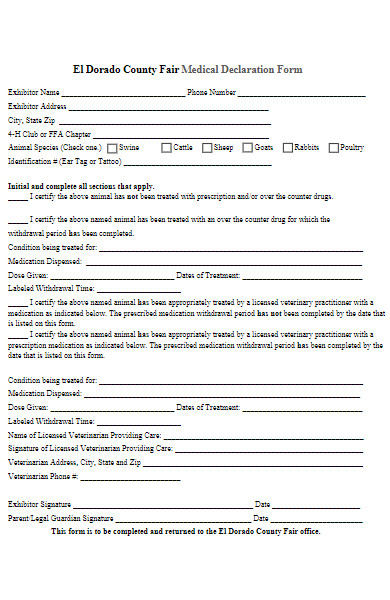
What is a Medical Self Declaration Form?
A Medical Self-Declaration Form, also known as a Self-Declaration of Health Form, is a document in which an individual provides information about their own health status, medical history, and potential exposure to infectious diseases or health conditions. This form is typically used in various contexts, such as travel, employment, or access to certain facilities, to assess whether the individual poses a health risk to others or themselves.
Key components of a Medical Self-Declaration Form may include:
- Personal Information: Name, contact details, date of birth, and other identifying information.
- Health Status: Information about current health conditions, recent symptoms, or illnesses.
- Travel History: Details about recent travel to areas with disease outbreaks or specific travel restrictions.
- Exposure History: Disclosure of potential exposure to infectious diseases, contact with infected individuals, or participation in high-risk activities.
- Vaccination Records: Information about vaccinations received, including dates and types.
- Consent: Acknowledgment of the individual’s willingness to comply with health and safety measures, such as quarantine or testing, if necessary.
- Signature and Date: The individual’s signature and the date of completion.
Medical Self-Declaration Forms are commonly used during public health emergencies, such as the COVID-19 pandemic, to assess and mitigate the spread of diseases. These printable forms help organizations, employers, and authorities make informed decisions about access, quarantine, or medical treatment, with the primary goal of safeguarding public health.
Why do I need a Medical Declaration Form?
You may need a Medical Declaration Form for several important reasons:
- Expressing Your Healthcare Preferences: A Medical Declaration Form allows you to articulate your specific healthcare preferences, including the types of treatments you desire or wish to refuse in various medical scenarios.
- Empowering Your Voice: By completing this form, you ensure that your healthcare decisions align with your values, beliefs, and personal wishes, even if you are unable to communicate them at a critical moment.
- Appointing a Healthcare Proxy: The form enables you to designate a trusted individual (healthcare proxy) to make medical decisions on your behalf when you are unable to do so, ensuring that someone who knows your preferences is advocating for your care.
- Legal Recognition: A properly executed Medical Declaration Form is legally binding in many jurisdictions, meaning that healthcare providers are generally obligated to follow the instructions you provide, helping safeguard your autonomy in medical matters.
- Reducing Confusion and Conflict: Having a clear and legally recognized document can reduce potential conflicts among family members or healthcare providers about the appropriate course of medical treatment, ensuring a smoother decision-making process.
- Peace of Mind: By completing this form, you gain peace of mind knowing that your healthcare wishes will be respected, providing reassurance during challenging medical situations.
- Emergency Situations: In emergencies, healthcare providers may need immediate guidance on your preferences. A Medical Declaration Form ensures that your wishes are readily available for reference.
- Compliance with Local Laws: Some jurisdictions may require specific documentation for certain healthcare decisions. A Medical Declaration Form helps ensure you comply with local legal requirements.
- End-of-Life Care: The form allows you to express your preferences for end-of-life care, ensuring that your desires for comfort care, life-sustaining treatments, or other interventions are known and respected.
- Clarity for Healthcare Providers: Healthcare professionals appreciate having clear instructions, which can assist them in providing appropriate care that aligns with your wishes.
In essence, a Medical Declaration Form is a valuable tool that empowers you to have a say in your medical care, even when you cannot communicate your preferences directly. It serves as a means to safeguard your autonomy, reduce potential conflicts, and provide clarity to both healthcare providers and your loved ones during critical healthcare situations. Our Medical form is also worth a look at
What happens if I don’t have a Medical Declaration Form?
If you don’t have a Medical Declaration Form in place, several potential consequences and challenges may arise in critical healthcare situations:
- Lack of Clarity: Without a documented expression of your healthcare preferences, there may be uncertainty about the medical treatments you desire or wish to refuse, leading to confusion among family members and healthcare providers.
- Potential Disputes: The absence of clear instructions can result in disagreements among family members regarding the appropriate course of treatment, potentially leading to disputes and emotional distress during an already stressful time.
- Delayed Decisions: In emergencies, healthcare providers may face delays in making critical decisions about your care if they cannot quickly determine your preferences. This delay could impact the timeliness and effectiveness of treatment.
- Unwanted Interventions: In the absence of your expressed preferences, healthcare providers may default to providing treatments that you may not desire or consider appropriate, potentially resulting in interventions that do not align with your values or beliefs.
- Legal Challenges: In some cases, family members or healthcare providers may seek legal guidance or court orders to make decisions on your behalf, which can be a time-consuming and emotionally taxing process for all parties involved.
- Stress for Loved Ones: Family members and loved ones may experience added stress and emotional burden when they are left to make difficult healthcare decisions on your behalf without clear guidance from you.
- Potential Conflict: Lack of clarity can lead to conflicts among family members, with each party advocating for different approaches to your care, causing further distress during an already challenging time.
- Missed Preferences: Without a designated healthcare proxy, someone who knows your preferences may not be legally authorized to make decisions on your behalf.
- Inefficiencies: Healthcare providers may resort to providing treatments that you might have refused or deemed unnecessary, potentially resulting in inefficiencies in care delivery and resource allocation.
In essence, not having a Medical Declaration Form can create uncertainty, emotional stress, and potential conflicts for both you and your loved ones during critical healthcare situations. Completing this form allows you to ensure that your healthcare preferences are known and respected, providing clarity and peace of mind for all involved parties. You can see our healthcare forms.
Is there an age limit for creating a Medical Declaration Form?
There is typically no specific age limit for creating a Medical Declaration Form. This document is not restricted by age and can be completed by individuals of any age who wish to express their healthcare preferences and designate a healthcare proxy.
In fact, it is advisable for adults of all ages to consider creating a Medical Declaration Form. Medical emergencies and unexpected health situations can occur at any stage of life, and having this document in place ensures that your healthcare wishes are known and respected, regardless of your age.
Young adults, in particular, may find it beneficial to create a Medical Declaration Form as they reach the age of legal adulthood, typically 18 years old. At this point, their parents or guardians no longer have automatic legal authority over their medical decisions. Therefore, it becomes important for young adults to have the means to express their preferences and designate a healthcare proxy if desired. In addition, you should review our Blank Medical Forms.
The key is to create and update the document as needed to reflect your current healthcare preferences and ensure that it complies with local laws and regulations. Consulting with legal or healthcare professionals can help ensure that your Medical Declaration Form is appropriately tailored to your circumstances and remains legally valid.
Can I revoke or change my Medical Declaration Form at any time?
Yes, you can typically revoke or change your Medical Declaration Form at any time, as long as you are of sound mind and capable of making healthcare decisions. It’s important to have the flexibility to update the document to reflect your evolving healthcare preferences. Here are some key considerations:
- Revocation: To revoke your Medical Declaration Form, you can create a new one that supersedes the previous version. In the new form, clearly state your intention to revoke all previous declarations. Be sure to distribute copies of the updated form to relevant parties, including your healthcare proxy and healthcare providers.
- Amendment: If you wish to make changes or amendments to your existing Medical Declaration Form without revoking it entirely, you can create an amendment or addendum. This document should outline the specific changes you want to make and reference the original form. Distribute copies of the amendment to the necessary parties.
- Communication: It’s advisable to communicate any changes or revocations to your healthcare proxy, family members, and healthcare providers to ensure that everyone is aware of your updated preferences. Open communication can help prevent misunderstandings during critical medical situations.
- Legal Requirements: Be aware of any legal requirements or formalities for revoking or amending the document in your jurisdiction. Some regions may require witnesses or notarization for changes to be legally valid.
- Frequent Review: Regularly review your Medical Declaration Form to ensure that it accurately reflects your current healthcare wishes. Changes in your health, personal circumstances, or values may prompt updates to the document.
- Consult Professionals: When making significant changes or revocations, consider consulting with legal or healthcare professionals who can provide guidance on the process and ensure that the document complies with local laws.
Remember that your ability to make changes to your Medical Declaration Form is a valuable aspect of this document, allowing you to maintain control over your healthcare preferences and ensure that they align with your current wishes and circumstances. You may also be interested in our Medical Report Form.
Can I create a Medical Declaration Form for my minor child?
Yes, you can create a Medical Declaration Form for your minor child, and doing so can be particularly important to ensure their healthcare preferences are known and respected in the event of a medical emergency or if you are unavailable. However, there are some important considerations to keep in mind:
- Legal Capacity: Depending on your jurisdiction, the legal capacity of a minor to make healthcare decisions may vary. In many cases, parents or legal guardians have the authority to make healthcare decisions for their minor children without the need for a separate document.
- Parental Consent: If you wish to create a Medical Declaration Form for your minor child, it’s advisable to consult with legal professionals or healthcare providers to ensure that the document complies with local laws and regulations. In some cases, it may be necessary to obtain consent from both parents or legal guardians.
- Content: The content of the form should specify the healthcare preferences and treatment instructions for your child, similar to an adult Medical Declaration Form. It can also designate a healthcare proxy or agent to make decisions on behalf of your child in case you are unavailable or incapacitated.
- Consideration of Age: The age of your child may influence the level of detail and complexity in the document. Older children may have more input into their healthcare preferences, while younger children may rely more on parental guidance.
- Communication: Ensure that your child understands the contents of the form to the extent that is age-appropriate. Open communication can help them feel comfortable with the document and its purpose.
- Accessibility: Store copies of the form in a secure but easily accessible location, and provide copies to relevant parties, such as your child’s healthcare providers and school, as needed.
- Review and Update: As your child grows and their healthcare needs change, it’s important to periodically review and update the form to reflect their current preferences and medical conditions.
- Legal Advice: Consulting with an attorney who specializes in family law and healthcare decisions for minors can provide valuable guidance and ensure that the document meets all legal requirements.
Creating a Medical Declaration Form for your minor child can help ensure that their healthcare wishes are known and followed, providing peace of mind for both you and your child in medical situations.
What is the role of an attorney in creating a Medical Declaration Form?
The role of an attorney in creating a Medical Declaration Form can be highly valuable, as legal professionals can provide expertise and guidance in ensuring that the document is legally valid, comprehensive, and tailored to your specific needs and circumstances. Here are some key roles and benefits of involving an attorney:
- Legal Compliance: Attorneys are well-versed in local, state, and federal laws and regulations related to healthcare decision-making, which ensures that your Medical Declaration Form complies with all legal requirements in your jurisdiction.
- Customization: An attorney can customize the form to reflect your unique healthcare preferences and values, ensuring that it accurately represents your wishes.
- Clarity and Precision: Attorneys have the expertise to draft clear and precise language in the document, minimizing the potential for misinterpretation or ambiguity.
- Witnessing and Notarization: In some jurisdictions, Medical Declaration Forms may require witnesses or notarization to be legally valid. An attorney can help arrange for these formalities, ensuring the document’s legal status.
- Review of Existing Documents: If you have previously created a Medical Declaration Form or related documents, an attorney can review them to ensure that they remain legally up-to-date and consistent with your current preferences.
- Comprehensive Consideration: Attorneys can guide you in considering various healthcare scenarios, potential treatments, and decision-making processes, helping you address a wide range of healthcare choices in the form.
- Coordination with Healthcare Providers: Attorneys can work with your healthcare providers to ensure that they understand and respect your preferences, helping to streamline communication and prevent potential conflicts.
- Family and Proxy Education: Attorneys can educate your chosen healthcare proxy or agent about their responsibilities and legal obligations, ensuring they are well-prepared to advocate for your care.
- Storage and Access: Your attorney can provide guidance on securely storing the document and ensuring that the right individuals, including healthcare providers and family members, have access to it when needed.
- Updates and Revisions: As your circumstances change or new healthcare options become available, an attorney can assist with updating and revising the document to keep it current.
Overall, involving an attorney in the creation of your Medical Declaration Form can help you navigate the complex legal and healthcare landscape, ensuring that your document is legally sound, comprehensive, and aligned with your healthcare preferences. It provides peace of mind, knowing that your healthcare choices will be respected in critical situations. You may also be interested to browse through our other Medical Application form.
How do I ensure that healthcare providers are aware of my Medical Declaration Form?
Ensuring that healthcare providers are aware of your Medical Declaration Form is crucial to guarantee that your healthcare preferences are followed in critical situations. Here are steps to help make healthcare providers aware of your document:
- Carry a Wallet Card or Bracelet: Create a wallet-sized card or wear a medical alert bracelet that indicates the existence of your Medical Declaration Form. These can include essential information and emergency contact details.
- Share with Primary Care Physician: Provide a copy of your Medical Declaration Form to your primary care physician or healthcare provider during routine visits. They can add it to your medical records, making it easily accessible in case of emergencies.
- Emergency Contact List: Maintain an updated list of your healthcare preferences, along with your healthcare proxy’s contact information, in a visible and easily accessible location in your home. Emergency responders may check for such information during emergencies.
- Notify Your Healthcare Proxy: Inform your designated healthcare proxy or agent about the existence and location of your Medical Declaration Form. They should be aware of their role in advocating for your healthcare choices.
- Hospital Admission: If you are admitted to a hospital, provide a copy of your Medical Declaration Form to the healthcare staff upon admission. Discuss your preferences with the admitting physician and nurse to ensure they are documented in your medical record.
- Speak with Hospital Social Workers: Hospital social workers can assist in coordinating care and ensuring that your preferences are communicated effectively to the healthcare team.
- Advance Directives Registry: In some regions, there are state or regional advance directives registries where you can electronically store and access your Medical Declaration Form. Notify healthcare providers that your document is registered, and they can retrieve it as needed.
- Emergency Medical Services (EMS): If you have a medical condition that may require frequent interaction with EMS, consider notifying your local EMS providers about the existence of your Medical Declaration Form so they can be prepared in case of emergencies.
- Inform Family Members: Ensure that close family members are aware of the form’s existence and location, especially those who may be present during medical emergencies.
- Regularly Review and Update: Periodically review and update your Medical Declaration Form to reflect any changes in your healthcare preferences. Distribute updated copies as needed.
Remember that communication is key. Clearly discuss your wishes with your healthcare proxy and loved ones so they can advocate for your care effectively in accordance with your Medical Declaration Form. Regularly reviewing and updating the document ensures that it remains current and accurately reflects your preferences.
How to Create a Medical Declaration Form?
Creating a Medical Declaration Form is an important step in ensuring your healthcare preferences are documented and respected. Here’s a step-by-step guide to help you create one:
Step 1: Understand Your Needs
Before you begin, consider your healthcare preferences and any specific treatments or interventions you want or wish to refuse. Think about scenarios such as end-of-life care, life support, organ donation, and pain management. Understanding your needs is crucial.
Step 2: Consult Legal Requirements
Research the legal requirements for Medical Declaration Forms in your jurisdiction. Laws may vary, so it’s essential to ensure your document complies with local regulations.
Step 3: Choose a Format
Decide whether you want to create a digital or paper document. Many templates are available online, or you can consult an attorney for guidance.
Step 4: Document Personal Information
Include your full legal name, date of birth, contact information, and any identifying details in the document.
Step 5: Appoint a Healthcare Proxy
Designate a healthcare proxy or agent who will make medical decisions on your behalf if you are unable to do so. Include their full name, contact information, and their relationship to you.
Step 6: Specify Healthcare Preferences
Clearly outline your healthcare preferences, including the following:
- Specific treatments or interventions you desire or wish to refuse.
- Under what conditions you want these treatments administered or withheld.
- End-of-life care instructions, such as your preference for comfort care or life-sustaining measures.
Step 7: Consider Mental Health Preferences
If applicable, express any preferences related to psychiatric treatment or mental healthcare.
Step 8: List Medical Conditions and Allergies
Include a list of your existing medical conditions, chronic illnesses, allergies, and medications you are taking. This information is crucial for healthcare providers.
Step 9: Obtain Witness Signatures
In some jurisdictions, you may need one or more witnesses to sign the document. Check local laws to determine if witnesses are required.
Step 10: Review and Notarization
Consider having the document reviewed by an attorney to ensure it complies with legal requirements. In some cases, notarization may be necessary for the document to be legally valid.
Step 11: Distribute Copies
Make multiple copies of your Medical Declaration Form. Provide copies to your healthcare proxy, family members, your primary care physician, and any specialists involved in your care.
Step 12: Periodic Review and Updates
Regularly review and update the document to reflect changes in your healthcare preferences or personal circumstances. Notify relevant parties of any updates.
Step 13: Communication
Discuss your healthcare preferences with your healthcare proxy and family members. Ensure they understand your wishes and are prepared to advocate for your care as specified in the document.
Remember that it’s essential to consult with legal professionals or healthcare experts to ensure that your Medical Declaration Form is legally valid, comprehensive, and aligned with your specific needs and local laws.
Tips for creating an Effective Medical Declaration Form
Creating an effective Medical Declaration Form is crucial to ensure that your healthcare preferences are clearly expressed and respected. Here are some tips to help you create an impactful and comprehensive document:
- Consult Legal Professionals: Seek guidance from attorneys or legal experts who specialize in healthcare directives. They can ensure that your form complies with local laws and regulations.
- Understand Your Preferences: Take time to reflect on your healthcare preferences and values. Consider different scenarios, including end-of-life care, life support, and specific medical treatments, to determine what matters most to you.
- Use Clear and Concise Language: Write your preferences in plain, easy-to-understand language. Avoid medical jargon or overly technical terms that could lead to misinterpretation.
- Specify Conditions: Clearly outline the circumstances under which you want specific treatments administered or withheld. Be explicit about your preferences for different healthcare scenarios.
- Appoint a Healthcare Proxy: Designate a trusted individual as your healthcare proxy or agent. Ensure they understand their role in advocating for your healthcare choices when you cannot communicate them yourself.
- Provide Contact Information: Include the full contact details of your healthcare proxy, primary care physician, and any specialists involved in your care. This ensures easy access to relevant parties in case of emergencies.
- Consider Mental Health Preferences: If relevant, express your preferences regarding psychiatric treatment or mental healthcare. Specify any treatments you wish to receive or refuse.
- List Medical Conditions and Allergies: Include an up-to-date list of your existing medical conditions, chronic illnesses, allergies, and medications. This information is crucial for healthcare providers.
- Include Witnesses: If required by local laws, have one or more witnesses sign the document to validate it. Ensure witnesses are not individuals named in the document.
- Review and Update Regularly: Periodically review your Medical Declaration Form to ensure it remains current. Update it as needed to reflect changes in your healthcare preferences or personal circumstances.
- Storage and Accessibility: Store copies of the document in a secure but easily accessible location. Inform relevant parties, including your healthcare proxy and family members, of its location.
- Discuss with Loved Ones: Communicate your healthcare preferences with your healthcare proxy and family members. Ensure they are aware of the document’s existence and understand your wishes.
- Seek Legal Review: Before finalizing the document, consider having it reviewed by an attorney or legal expert to ensure its legal validity and alignment with local laws.
- Consider Additional Documents: Depending on your circumstances, you may want to create related documents like a living will or durable power of attorney for healthcare to address specific healthcare decisions.
- Emergency Contact Card: Carry a wallet-sized card or wear a medical alert bracelet indicating the existence of your Medical Declaration Form, along with essential information and emergency contact details.
Creating an effective Medical Declaration Form requires careful consideration, legal guidance, and open communication with your healthcare proxy and loved ones. It ensures that your healthcare choices are clearly expressed and respected in critical medical situations.
In summary, a Medical Declaration Form is a vital document that empowers individuals to articulate their healthcare preferences and appoint a healthcare proxy. It ensures that one’s medical choices are respected, even when they cannot communicate them. Whether for end-of-life care, specific treatments, or mental health preferences, these fillable form provides clarity and legal validity. Creating it involves careful consideration, legal consultation, and open communication. Regular updates keep it aligned with evolving healthcare needs, ensuring peace of mind in critical medical situations.
Related Posts
FREE 9+ Sample Medical Certification Forms in PDF MS Word
FREE 7+ Pre Employment Physical Forms in PDF
FREE 18+ Sample Reimbursement Forms in PDF MS Word | Excel
FREE 8+ Sample Free Living Will Forms in PDF MS Word
FREE 30+ Medical Clearance Form Samples in PDF MS Word
FREE 4+ Medical Card Application Forms in PDF
FREE 15+ Medical Information Forms in MS Word PDF | Excel
FREE 10+ Patient Information Forms in PDF Ms Word
FREE 35+ Power of Attorney Forms in PDF
FREE 9+ Sample Medical Application Forms in PDF MS Word | Excel
FREE 7+ Sample Training Application Forms in PDF MS Word
FREE 9+ Sample Health Declaration Forms in MS Word PDF | Excel
FREE 9+ Sample Travel Health Forms in PDF MS Word
FREE 36+ Medical Forms in PDF MS Word | Excel
FREE 10+ Employment Declaration Form Samples in PDF MS Word
